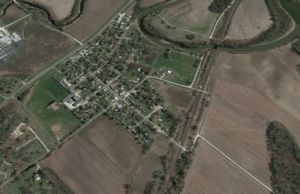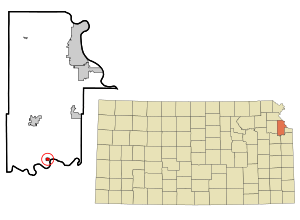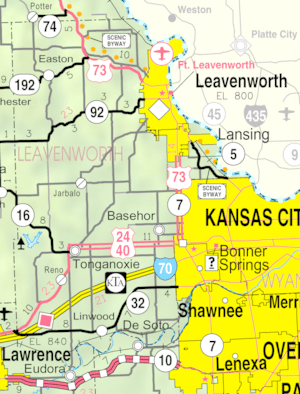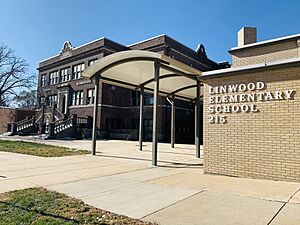Linwood, Kansas facts for kids
Quick facts for kids
Linwood, Kansas
|
|
|---|---|

Aerial view of Linwood (2017)
|
|

Location within Leavenworth County and Kansas
|
|

|
|
| Country | United States |
| State | Kansas |
| County | Leavenworth |
| Founded | 1860s |
| Platted | 1867 |
| Incorporated | 1895 |
| Named for | Linden tree |
| Area | |
| • Total | 0.60 sq mi (1.56 km2) |
| • Land | 0.58 sq mi (1.51 km2) |
| • Water | 0.02 sq mi (0.05 km2) |
| Elevation | 804 ft (245 m) |
| Population
(2020)
|
|
| • Total | 415 |
| • Density | 692/sq mi (266.0/km2) |
| Time zone | UTC-6 (CST) |
| • Summer (DST) | UTC-5 (CDT) |
| ZIP code |
66052
|
| Area code | 913 |
| GNIS ID | 2395727 |
Linwood is a small city in Leavenworth County, Kansas, in the United States. It is part of the larger Kansas City metropolitan area. In 2020, about 415 people lived there. Linwood is located along K-32 highway, between the cities of Lawrence and Bonner Springs.
Contents
History of Linwood
How Linwood Began
Linwood was first called Journeycake. It was named after Charles Journeycake, who was the last chief of the Delaware tribe. Sometimes, people would jokingly call it "Johnny Cake." The town was planned out on both sides of Stranger Creek, close to where the creek meets the Kansas River.
In May 1860, a special agreement was signed near Linwood. This agreement was between Chief Sarcoxie of the Delaware tribe and the United States government. After this, each tribe member received a piece of land. The rest of the tribe's land was sold to the company that later became the Union Pacific Railroad. The U.S. government also set up a trading post near Stranger Creek. This was used until the tribe moved to the Indian Territory in 1867. This trading post, located by the Union Pacific Railroad tracks, became the community's first school.
The Union Pacific Railroad's Role
In September 1863, the Union Pacific Railroad started building its main railway line. This line stretched west across the Great Plains from Kansas City, Kansas, towards Denver, Colorado. For a few years, this was the longest railroad in Kansas. The first 40 miles (64 km) of track opened in 1864. This part went from Wyandotte (which is now a part of Kansas City) to Lawrence. William A. Harris, a civil engineer, moved to Kansas in 1865 to work for the Union Pacific Railroad. In 1868, the railroad company changed its name to the Kansas Pacific Railroad.
Why the Name Changed to Linwood
The original town of Journeycake was officially named Stranger on July 11, 1867. This name was recorded at the Leavenworth County Courthouse. However, the name "Stranger" caused problems for the Postal Service. They often mixed it up with another nearby town also called Stranger. Because of this confusion, the town was renamed Linwood on December 20, 1877.
A popular story says that Colonel Loring suggested the name Linwood. This happened while citizens were cutting wood for a church. He suggested it because many linden trees grew in the area. However, historical records say that Senator William A. Harris changed the name. He did this because he really liked the linden trees that were common near Stranger Creek.
Senator William A. Harris
William A. Harris moved to Kansas in 1865. He worked as a civil engineer for the Union Pacific Railroad until 1868. After that, he moved to Lawrence, Kansas. He was chosen to manage the sale of land from the Delaware Reservation and other areas for the railroad companies.
In 1884, Harris became an important person in Linwood. He started farming and raising animals. He bought about 100 acres (0.40 km2) of land just west of Linwood. On a tall hill overlooking the city, he built a large, two-story house with fifteen rooms, known as the Harris House. Harris was elected to the U.S. Congress as a Democrat from 1893 to 1895. Later, he was elected to the U.S. Senate as a Populist from 1897 to 1903. He tried to become the Governor of Kansas in 1906 but did not win. Harris passed away in 1909 and is buried in Lawrence, Kansas.
Linwood's Relocation After a Flood
A lot of Linwood's business came from sawmills along the Kansas River. The city had grown very close to the riverbanks. This river, also called the “Kaw” River, flows east to the Missouri River. In 1903, a big flood caused a lot of damage and danger to Linwood. Because of this, the city was moved about one mile (1.6 km) north. It is now in its current spot, away from the low-lying areas near the river. These areas are still known as “the bottoms” today.
Linwood in the 21st Century
Today, Linwood is a small city. You can mostly reach it by using ![]() K-32. The Golden Road bridge over Stranger Creek fell down in the early 2000s and has not been rebuilt. Currently, the city has fewer than 400 people. However, since 2019, many new homes have been built, bringing new families to the area. Linwood has several businesses, including a gas station, a tavern, a landscaping company, a salsa factory, and a Dollar General store. Linwood is also home to one of the Basehor-Linwood Elementary Schools. The Basehor-Linwood Middle and High Schools are located in Basehor.
K-32. The Golden Road bridge over Stranger Creek fell down in the early 2000s and has not been rebuilt. Currently, the city has fewer than 400 people. However, since 2019, many new homes have been built, bringing new families to the area. Linwood has several businesses, including a gas station, a tavern, a landscaping company, a salsa factory, and a Dollar General store. Linwood is also home to one of the Basehor-Linwood Elementary Schools. The Basehor-Linwood Middle and High Schools are located in Basehor.
The 2019 Tornado Event
On May 28, 2019, a very strong tornado hit the areas just outside of Linwood. This tornado was an EF4, meaning it had very high wind speeds, over 187 miles per hour (301 km/h). It caused serious damage to many homes. At least 13 people were hurt because of the storm. The city of Linwood itself was lucky and did not get much major damage. There was only some roof damage and a loss of trees and fences.
Geography of Linwood
Linwood is located along the north bank of the Kansas River. According to the United States Census Bureau, the city covers a total area of about 0.73 square miles (1.89 square kilometers). Most of this area, about 0.71 square miles (1.84 square kilometers), is land. A small part, about 0.02 square miles (0.05 square kilometers), is water.
Linwood's Population
| Historical population | |||
|---|---|---|---|
| Census | Pop. | %± | |
| 1880 | 125 | — | |
| 1890 | 306 | 144.8% | |
| 1900 | 349 | 14.1% | |
| 1910 | 323 | −7.4% | |
| 1920 | 364 | 12.7% | |
| 1930 | 295 | −19.0% | |
| 1940 | 299 | 1.4% | |
| 1950 | 261 | −12.7% | |
| 1960 | 375 | 43.7% | |
| 1970 | 323 | −13.9% | |
| 1980 | 343 | 6.2% | |
| 1990 | 409 | 19.2% | |
| 2000 | 374 | −8.6% | |
| 2010 | 375 | 0.3% | |
| 2020 | 415 | 10.7% | |
| U.S. Decennial Census | |||
Population in 2020
The 2020 United States census counted 415 people living in Linwood. There were 153 households and 105 families. This means there were about 712 people per square mile (275 per square kilometer). Most people, about 90.84%, were white. A small number were Native American, Asian, or Pacific Islander. About 7.95% of the people were of two or more races. About 5.3% of the population was Hispanic or Latino.
In the households, 45.8% had children under 18 years old. About 51.0% were married couples living together. The average household had 2.5 people, and the average family had 2.9 people. About 26.5% of the population was under 18 years old. The average age in the city was 35.1 years. For every 100 females, there were about 99.5 males.
Population in 2010
According to the census from 2010, there were 375 people living in Linwood. There were 139 households and 92 families. The population density was about 528 people per square mile (204 per square kilometer). Most of the people, 92.5%, were White. About 6.9% of the population was Hispanic or Latino.
In 2010, 37.4% of households had children under 18. About 42.4% were married couples. The average household size was 2.70 people, and the average family size was 3.14 people. The median age in Linwood was 31.8 years. About 27.2% of residents were under 18 years old. About 53.3% of the population was male, and 46.7% was female.
Notable People from Linwood
- William Harris (1841–1909), a well-known Kansas senator.
- Charles Journeycake (1817–1894), the founder of Linwood.
See also
In Spanish: Linwood (Kansas) para niños


